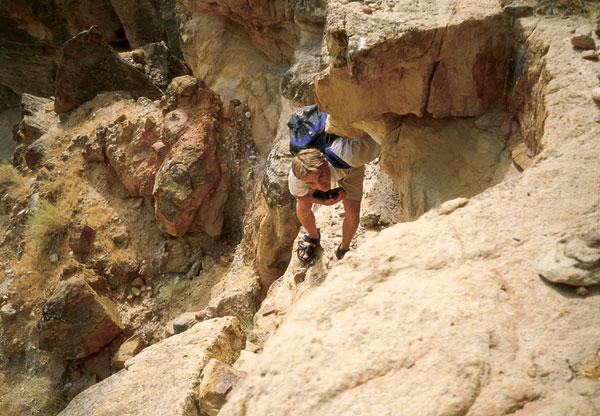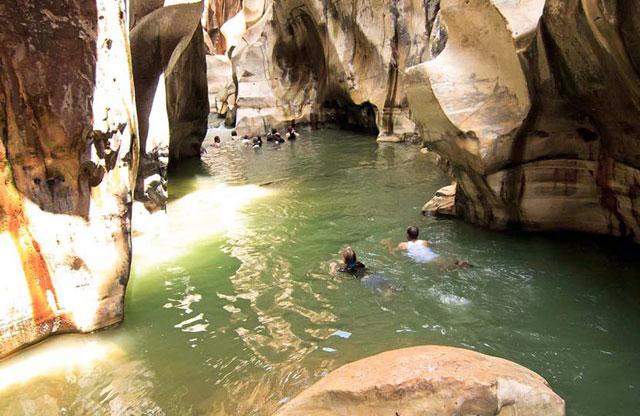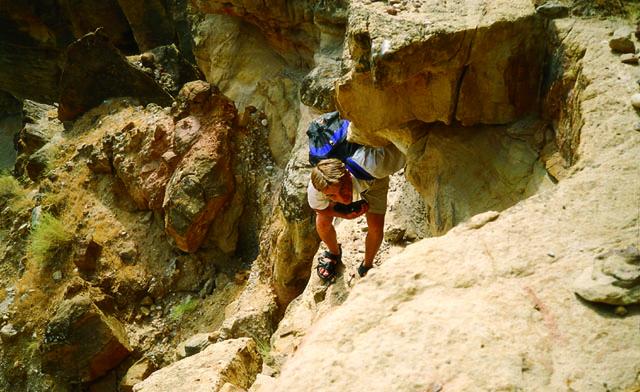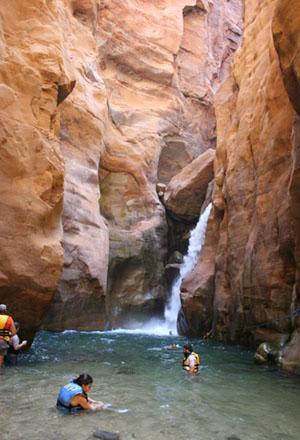You are here
New adventure season begins at Mujib reserve
By Hana Namrouqa - Apr 14,2016 - Last updated at Apr 14,2016

Covering an area of 220 square kilometres, the Mujib Biosphere Reserve is home to seasonal and permanent rivers that flow through several valleys, as well as ponds and waterfalls (Photo courtesy of Royal Society for Conservation of Nature)
AMMAN — The Mujib Biosphere Reserve has reopened for another adventure season, offering this year two new activities to thrill seekers, the reserve’s director, Hisham Dheisat, said on Thursday.
In addition to its four trails — the dry Ibex Trail and the Siq, Canyon and Malqi water trails — the Mujib Biosphere Reserve now offers its visitors zip line and climbing activities.
“Within a month, visitors to our reserve can zip-line or climb a natural rock wall,” Dheisat told The Jordan Times.
Visitors to the reserve will also be greeted this year at the new visitors’ centre, which now can host a larger number of tourists, he said, noting that the reserve’s chalets that overlook the Dead Sea were also refurbished.
An eco-tourism destination for hiking and camping, the Mujib reserve is home to high-altitude summits and waterfalls. It closes every winter due to flash floods and rising water levels in its valleys and trails, reopening in spring.
As the water trails at the reserve change during winter due to heavy rain and flash floods, the Royal Society for the Conservation of Nature (RSCN), which manages the Kingdom’s nature reserves, dispatches a specialised safety team before the start of every adventure season to inspect the condition of the trails and to re-evaluate their risk levels.
“Visitors’ safety is our main concern and a red line. Visitors are briefed on the trail they are about to take and are provided with life vests, which they are not allowed to take off while in the water trails. In addition, there are lifeguards and ropes that assist visitors hiking along the water valleys and up the waterfalls, as well as warning signs at dangerous locations,” Dheisat noted.
On weekends, when the number of visitors increases, Civil Defence Department personnel are deployed as a standard safety measure at the reserve.
“A total of 12,000 tourists visited the reserve last year, which is a drop compared to previous years. The rehabilitation of the reserve’s visitor centre and chalets is the reason behind the decrease in the number of visitors,” Dheisat said.
Usually, two thirds of the visitors are Jordanians, according to the reserve director, who said that the majority of visitors select the Siq Trail, a self-guided and easy to moderate water trail.
Covering an area of 220 square kilometres, the Mujib Biosphere Reserve is home to seasonal and permanent rivers that flow through several valleys, as well as ponds and waterfalls.
Three large catchments — Wadi Mujib, Wadi Hidan and Wadi Zarqa — characterise the area’s complex drainage system with its permanent water flow throughout the year.
The richest vegetation is found in the wadi beds, including oleander, palm, wild fig and tamarix trees, as well as reed beds along riverbanks, according to the RSCN.
Surveys indicate that Mujib, the lowest-altitude nature reserve in the world, is home to over 300 species of plants, 10 species of carnivores, and numerous species of resident and migratory birds.
Bordered by the Rift Valley, the world’s second-most used flyway, which hosts more than 1.5 million migratory birds during the spring and autumn, the reserve is strategically important for bird migration.
Related Articles
AMMAN — The Mujib Biosphere Reserve will open for a new adventure season with stricter safety measures to minimise risks and protect adventu
Heavy rain during the winter created two new ponds in the Siq Trail at the Mujib Biosphere Reserve, which has reopened for another adventure season, reserve director, Hisham Dheisat, said on Wednesday.
The Mujib Biosphere Reserve has reopened for another adventure season with additional safety measures in place to protect its visitors, according to its director, Hisham Dheisat.

















